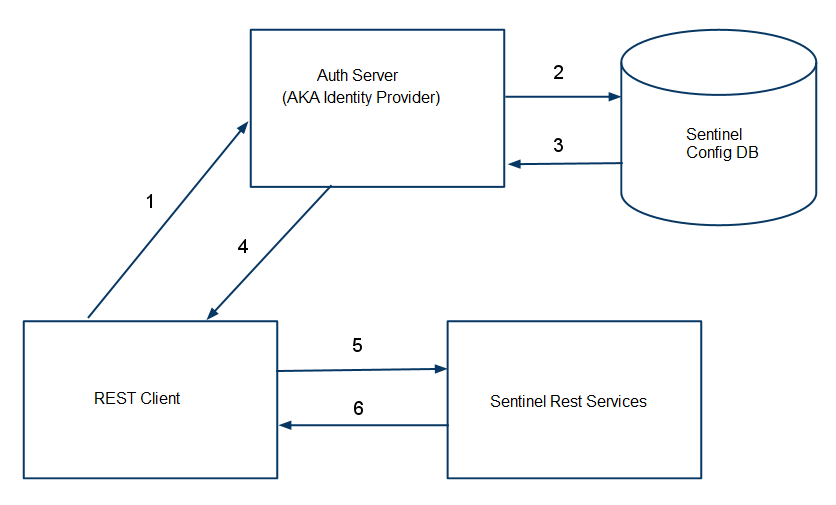
Access to the majority of the functionality in Sentinel is accessible via an Application Programming Interface (API). This API is an HTTP based one, and is a RESTful programming interface.
| Resource | GET | PUT | POST | DELETE |
|---|---|---|---|---|
| Collection URI, such as http://example.com/resources/ | List the URIs and perhaps other details of the collection's members. | Replace the entire collection with another collection. | Create a new entry in the collection. The new entry's URL is assigned automatically and is usually returned by the operation. | Delete the entire collection. |
| Element URI, such as http://example.com/resources/142 | Retrieve a representation of the addressed member of the collection, expressed in an appropriate Internet media type. | Replace the addressed member of the collection, or if it doesn't exist, create it. | Treat the addressed member as a collection in its own right and create a new entry in it. | Delete the addressed member of the collection. |

| Request | curl -k -XPOST -H "Authorization: Basic YWRtaW46bm92ZWxs" "https://localhost:8443/SentinelAuthServices/auth/tokens" |
|---|---|
| Response | {"Token":"nVbZkqJKEH33KwznscNmUWwwWifYRFBUBLWblwkoikVZlAJZvv6ijjN2R8+NuTfCB/OQmXVOZWVVvn4vo7B9hikKknjUIZ7xThvGIHGC2Bt1NsakS3e+j1+RFYXkkEUIplnj2G6CYjS8oqNOnsbDxEIBGsZWBNEwA0OdVedD8hkfWveQTlsWRp0BPaABidtdAlCg27f7TNeiB3Z34Lo4JCiLciiy8UQoh3KMMivORh0SJ4gu3vwog6CHJD7sMc+9PmF22ts77Walzp3kNTgd//iBYJwFMQzZPPN1mDYaf/x4xT44vTpoqAdebGV5Cn+KctCo42fZcYhhRVE8F73nJPUwEsdxDGewxsdBgfetM27dg6Ejx25ys3krTuIAWGFQWxfVKsz8xGmzoZekQeZHf0hNYAR+Sd2FJegCoh9/62C/F7iy+8tMH0imyOoi3yLuydbQhWlTXdjerOVR59tfVeMWaqRWjNwkjdAn+78xgvEZhskROl10F3Yn9/cZv9it8SsEQzkGYY6CM1xcjuHRAhD9rCkEf5+qvUqhG5TzADVnz0Ht64FpSL5ijyQbztgX2yIEHkTZ/6nVY51uWbZWmMNxDo4J6cSOt6gwXuXq46oCpKAscwaMrhQenW+kfpX5p/35kP46Uz+DuLlESmc95DRyT81JViL1rX3qLVd43Vci3dQq8f1sx8qp3k3ZgwWQgZBIaXPPIiIc0j4T9+bBLAM7NSZadegme7qIegYmocVgO1ulTz4wNhUZSIt87TNzSKg6sy9KVVPeaZWuQL3OLLzZsmm0nSUHypq8KXG9AlzQmu6lKeNoFbkBoTcg/cGSHf3W9KjhomsGq6vIy/83CmcEK7N+GfzlGnKb1szgWJVlXq95nrV1jy1kjvVk0Vha5ZPALjjvcPIPgcQUOMdqmwkrcCdVQwWvvQtbTZPEQtluanGusgeJJTZii+dUfhuJpVBfghdbjgUGF5pHc0fl74a4Uln86sj7qmREDGnuSqSuxUIorgnnYuErprTNHSnEW9AQTZUD1wC22aHNVDnb5LunvW1xa7IIQWyGYM/CSYGXqiCWqnEoF7VcLAzTumIGW6kGuGKtC6hKScnXrHJj9m6w4dZ4kCM3cnaPLLlSlbZRGNoR5asaXQg3v1lLLMyl3TNDWypK0WBXt4TI4MXw0EjFrbc1pa4PxeQmq+HGaSBizmbAcc7bOtmQ28qJtpUqS27rshqvnyRdtnuCJl42mmX70oIVeC7QZpyn8ad9DquIstKnurD3Cgby1eFFIqu1LKhZ342UtP8SK64stpSc4U7VYcKcd/xsnvjJ4MSHU5GZkbGzwoPdLinmdpi5i9yhWECfCtKeGpCal0bY4zdmjOYFQWsi4R+g2wJciZn+wSp7xslar/trX5cmDNqcik0/eMKz/U4RslOPlqU9flruzH5JRlQhC6zGcp9VtbibLI5lvZSGYPVUu1ZWR+nU5Pk+cgJ6ZVov+Bus3iqNHZiB4QQDhSZgVpA83tvwT4P3mGOaNinelq2qJ09faoleHlkNbU9UQolisSrrYjMIqqnHy3itcTUOfXtCnb3Txj3viZdK32izueaCCbZMdORa+nFt97DWE1zSdF4eyqyvKO8sjjPJHj+oT+t1AK799bllfoG3psIe2+1DP96fYT239xBkd/NyJctCe9JclVb255GBeCauSOB03avrMI/REYKGBnQ6Y8uJgvj+ht9Sju/mpwUvr36sZw33qJkDPqB8Emew/BLjw2Zgae7P8b/ONGAILn4N/MDuzuPLdF99/Ag+UL3D99Fp/A8="} |
| Note | YWRtaW46bm92ZWxs is in base64encode(admin:novell), modify this for appropriate user. |
| Request | curl -k -v -XGET -H "Authorization: X-SAML nVbZkqJKEH33KwznscNmUWwwWifYRFBUBLWblwkoikVZlAJZvv6ijjN2R8+NuTfCB/OQmXVOZWVVvn4vo7B9hikKknjUIZ7xThvGIHGC2Bt1NsakS3e+j1+RFYXkkEUIplnj2G6CYjS8oqNOnsbDxEIBGsZWBNEwA0OdVedD8hkfWveQTlsWRp0BPaABidtdAlCg27f7TNeiB3Z34Lo4JCiLciiy8UQoh3KMMivORh0SJ4gu3vwog6CHJD7sMc+9PmF22ts77Walzp3kNTgd//iBYJwFMQzZPPN1mDYaf/x4xT44vTpoqAdebGV5Cn+KctCo42fZcYhhRVE8F73nJPUwEsdxDGewxsdBgfetM27dg6Ejx25ys3krTuIAWGFQWxfVKsz8xGmzoZekQeZHf0hNYAR+Sd2FJegCoh9/62C/F7iy+8tMH0imyOoi3yLuydbQhWlTXdjerOVR59tfVeMWaqRWjNwkjdAn+78xgvEZhskROl10F3Yn9/cZv9it8SsEQzkGYY6CM1xcjuHRAhD9rCkEf5+qvUqhG5TzADVnz0Ht64FpSL5ijyQbztgX2yIEHkTZ/6nVY51uWbZWmMNxDo4J6cSOt6gwXuXq46oCpKAscwaMrhQenW+kfpX5p/35kP46Uz+DuLlESmc95DRyT81JViL1rX3qLVd43Vci3dQq8f1sx8qp3k3ZgwWQgZBIaXPPIiIc0j4T9+bBLAM7NSZadegme7qIegYmocVgO1ulTz4wNhUZSIt87TNzSKg6sy9KVVPeaZWuQL3OLLzZsmm0nSUHypq8KXG9AlzQmu6lKeNoFbkBoTcg/cGSHf3W9KjhomsGq6vIy/83CmcEK7N+GfzlGnKb1szgWJVlXq95nrV1jy1kjvVk0Vha5ZPALjjvcPIPgcQUOMdqmwkrcCdVQwWvvQtbTZPEQtluanGusgeJJTZii+dUfhuJpVBfghdbjgUGF5pHc0fl74a4Uln86sj7qmREDGnuSqSuxUIorgnnYuErprTNHSnEW9AQTZUD1wC22aHNVDnb5LunvW1xa7IIQWyGYM/CSYGXqiCWqnEoF7VcLAzTumIGW6kGuGKtC6hKScnXrHJj9m6w4dZ4kCM3cnaPLLlSlbZRGNoR5asaXQg3v1lLLMyl3TNDWypK0WBXt4TI4MXw0EjFrbc1pa4PxeQmq+HGaSBizmbAcc7bOtmQ28qJtpUqS27rshqvnyRdtnuCJl42mmX70oIVeC7QZpyn8ad9DquIstKnurD3Cgby1eFFIqu1LKhZ342UtP8SK64stpSc4U7VYcKcd/xsnvjJ4MSHU5GZkbGzwoPdLinmdpi5i9yhWECfCtKeGpCal0bY4zdmjOYFQWsi4R+g2wJciZn+wSp7xslar/trX5cmDNqcik0/eMKz/U4RslOPlqU9flruzH5JRlQhC6zGcp9VtbibLI5lvZSGYPVUu1ZWR+nU5Pk+cgJ6ZVov+Bus3iqNHZiB4QQDhSZgVpA83tvwT4P3mGOaNinelq2qJ09faoleHlkNbU9UQolisSrrYjMIqqnHy3itcTUOfXtCnb3Txj3viZdK32izueaCCbZMdORa+nFt97DWE1zSdF4eyqyvKO8sjjPJHj+oT+t1AK799bllfoG3psIe2+1DP96fYT239xBkd/NyJctCe9JclVb255GBeCauSOB03avrMI/REYKGBnQ6Y8uJgvj+ht9Sju/mpwUvr36sZw33qJkDPqB8Emew/BLjw2Zgae7P8b/ONGAILn4N/MDuzuPLdF99/Ag+UL3D99Fp/A8=" "https://localhost:8443/SentinelRESTServices/preauthorize?path=/objects/identity&httpMethod=GET" |
|---|---|
| Response | {"Authorized":"true"} |
| Note | The X-SAML token in the header is used to identify the user |
| Request | curl -k -XGET -H "Authorization: Basic YWRtaW46bm92ZWxs" "https://localhost:8443/SentinelAuthServices/auth/tokens/nVbZkqJKEH33KwznscNmUWwwWifYRFBUBLWblwkoikVZlAJZvv6ijjN2R8%2BNuTfCB%2FOQmXVOZWVVvn4vo7B9hikKknjUIZ7xThvGIHGC2Bt1NsakS3e%2Bj1%2BRFYXkkEUIplnj2G6CYjS8oqNOnsbDxEIBGsZWBNEwA0OdVedD8hkfWveQTlsWRp0BPaABidtdAlCg27f7TNeiB3Z34Lo4JCiLciiy8UQoh3KMMivORh0SJ4gu3vwog6CHJD7sMc%2B9PmF22ts77Walzp3kNTgd%2F%2FiBYJwFMQzZPPN1mDYaf%2Fx4xT44vTpoqAdebGV5Cn%2BKctCo42fZcYhhRVE8F73nJPUwEsdxDGewxsdBgfetM27dg6Ejx25ys3krTuIAWGFQWxfVKsz8xGmzoZekQeZHf0hNYAR%2BSd2FJegCoh9%2F62C%2FF7iy%2B8tMH0imyOoi3yLuydbQhWlTXdjerOVR59tfVeMWaqRWjNwkjdAn%2B78xgvEZhskROl10F3Yn9%2FcZv9it8SsEQzkGYY6CM1xcjuHRAhD9rCkEf5%2BqvUqhG5TzADVnz0Ht64FpSL5ijyQbztgX2yIEHkTZ%2F6nVY51uWbZWmMNxDo4J6cSOt6gwXuXq46oCpKAscwaMrhQenW%2BkfpX5p%2F35kP46Uz%2BDuLlESmc95DRyT81JViL1rX3qLVd43Vci3dQq8f1sx8qp3k3ZgwWQgZBIaXPPIiIc0j4T9%2BbBLAM7NSZadegme7qIegYmocVgO1ulTz4wNhUZSIt87TNzSKg6sy9KVVPeaZWuQL3OLLzZsmm0nSUHypq8KXG9AlzQmu6lKeNoFbkBoTcg%2FcGSHf3W9KjhomsGq6vIy%2F83CmcEK7N%2BGfzlGnKb1szgWJVlXq95nrV1jy1kjvVk0Vha5ZPALjjvcPIPgcQUOMdqmwkrcCdVQwWvvQtbTZPEQtluanGusgeJJTZii%2BdUfhuJpVBfghdbjgUGF5pHc0fl74a4Uln86sj7qmREDGnuSqSuxUIorgnnYuErprTNHSnEW9AQTZUD1wC22aHNVDnb5LunvW1xa7IIQWyGYM%2FCSYGXqiCWqnEoF7VcLAzTumIGW6kGuGKtC6hKScnXrHJj9m6w4dZ4kCM3cnaPLLlSlbZRGNoR5asaXQg3v1lLLMyl3TNDWypK0WBXt4TI4MXw0EjFrbc1pa4PxeQmq%2BHGaSBizmbAcc7bOtmQ28qJtpUqS27rshqvnyRdtnuCJl42mmX70oIVeC7QZpyn8ad9DquIstKnurD3Cgby1eFFIqu1LKhZ342UtP8SK64stpSc4U7VYcKcd%2FxsnvjJ4MSHU5GZkbGzwoPdLinmdpi5i9yhWECfCtKeGpCal0bY4zdmjOYFQWsi4R%2Bg2wJciZn%2BwSp7xslar%2FtrX5cmDNqcik0%2FeMKz%2FU4RslOPlqU9flruzH5JRlQhC6zGcp9VtbibLI5lvZSGYPVUu1ZWR%2BnU5Pk%2BcgJ6ZVov%2BBus3iqNHZiB4QQDhSZgVpA83tvwT4P3mGOaNinelq2qJ09faoleHlkNbU9UQolisSrrYjMIqqnHy3itcTUOfXtCnb3Txj3viZdK32izueaCCbZMdORa%2BnFt97DWE1zSdF4eyqyvKO8sjjPJHj%2BoT%2Bt1AK799bllfoG3psIe2%2B1DP96fYT239xBkd%2FNyJctCe9JclVb255GBeCauSOB03avrMI%2FREYKGBnQ6Y8uJgvj%2Bht9Sju%2FmpwUvr36sZw33qJkDPqB8Emew%2FBLjw2Zgae7P8b%2FONGAILn4N%2FMDuzuPLdF99%2FAg%2BUL3D99Fp%2FA8%3D" |
|---|---|
| Response | {"UserId":"admin","FirstName":"Arnie","LastName":"Admin","Initials":"AA","Email":"arnie@admin.com","Expiration":"1294255239335","Roles":["distSearchAccept","distSearchInitiate","isReportManager","manageTags","runReportOnDB","viewInternalEvents"]} |
| Note | Token on URL on curl request is url encoded version of token returned in "Create SAML Token" |
| Request | curl -k -XDELETE -H "Authorization: Basic YWRtaW46bm92ZWxs" "https://localhost:8443/SentinelAuthServices/auth/tokens/nVbZkqJKEH33KwznscNmUWwwWifYRFBUBLWblwkoikVZlAJZvv6ijjN2R8%2BNuTfCB%2FOQmXVOZWVVvn4vo7B9hikKknjUIZ7xThvGIHGC2Bt1NsakS3e%2Bj1%2BRFYXkkEUIplnj2G6CYjS8oqNOnsbDxEIBGsZWBNEwA0OdVedD8hkfWveQTlsWRp0BPaABidtdAlCg27f7TNeiB3Z34Lo4JCiLciiy8UQoh3KMMivORh0SJ4gu3vwog6CHJD7sMc%2B9PmF22ts77Walzp3kNTgd%2F%2FiBYJwFMQzZPPN1mDYaf%2Fx4xT44vTpoqAdebGV5Cn%2BKctCo42fZcYhhRVE8F73nJPUwEsdxDGewxsdBgfetM27dg6Ejx25ys3krTuIAWGFQWxfVKsz8xGmzoZekQeZHf0hNYAR%2BSd2FJegCoh9%2F62C%2FF7iy%2B8tMH0imyOoi3yLuydbQhWlTXdjerOVR59tfVeMWaqRWjNwkjdAn%2B78xgvEZhskROl10F3Yn9%2FcZv9it8SsEQzkGYY6CM1xcjuHRAhD9rCkEf5%2BqvUqhG5TzADVnz0Ht64FpSL5ijyQbztgX2yIEHkTZ%2F6nVY51uWbZWmMNxDo4J6cSOt6gwXuXq46oCpKAscwaMrhQenW%2BkfpX5p%2F35kP46Uz%2BDuLlESmc95DRyT81JViL1rX3qLVd43Vci3dQq8f1sx8qp3k3ZgwWQgZBIaXPPIiIc0j4T9%2BbBLAM7NSZadegme7qIegYmocVgO1ulTz4wNhUZSIt87TNzSKg6sy9KVVPeaZWuQL3OLLzZsmm0nSUHypq8KXG9AlzQmu6lKeNoFbkBoTcg%2FcGSHf3W9KjhomsGq6vIy%2F83CmcEK7N%2BGfzlGnKb1szgWJVlXq95nrV1jy1kjvVk0Vha5ZPALjjvcPIPgcQUOMdqmwkrcCdVQwWvvQtbTZPEQtluanGusgeJJTZii%2BdUfhuJpVBfghdbjgUGF5pHc0fl74a4Uln86sj7qmREDGnuSqSuxUIorgnnYuErprTNHSnEW9AQTZUD1wC22aHNVDnb5LunvW1xa7IIQWyGYM%2FCSYGXqiCWqnEoF7VcLAzTumIGW6kGuGKtC6hKScnXrHJj9m6w4dZ4kCM3cnaPLLlSlbZRGNoR5asaXQg3v1lLLMyl3TNDWypK0WBXt4TI4MXw0EjFrbc1pa4PxeQmq%2BHGaSBizmbAcc7bOtmQ28qJtpUqS27rshqvnyRdtnuCJl42mmX70oIVeC7QZpyn8ad9DquIstKnurD3Cgby1eFFIqu1LKhZ342UtP8SK64stpSc4U7VYcKcd%2FxsnvjJ4MSHU5GZkbGzwoPdLinmdpi5i9yhWECfCtKeGpCal0bY4zdmjOYFQWsi4R%2Bg2wJciZn%2BwSp7xslar%2FtrX5cmDNqcik0%2FeMKz%2FU4RslOPlqU9flruzH5JRlQhC6zGcp9VtbibLI5lvZSGYPVUu1ZWR%2BnU5Pk%2BcgJ6ZVov%2BBus3iqNHZiB4QQDhSZgVpA83tvwT4P3mGOaNinelq2qJ09faoleHlkNbU9UQolisSrrYjMIqqnHy3itcTUOfXtCnb3Txj3viZdK32izueaCCbZMdORa%2BnFt97DWE1zSdF4eyqyvKO8sjjPJHj%2BoT%2Bt1AK799bllfoG3psIe2%2B1DP96fYT239xBkd%2FNyJctCe9JclVb255GBeCauSOB03avrMI%2FREYKGBnQ6Y8uJgvj%2Bht9Sju%2FmpwUvr36sZw33qJkDPqB8Emew%2FBLjw2Zgae7P8b%2FONGAILn4N%2FMDuzuPLdF99%2FAg%2BUL3D99Fp%2FA8%3D" |
|---|---|
| Response | {"GUID":"nVbZkqJKEH33KwznscNmUWwwWifYRFBUBLWblwkoikVZlAJZvv6ijjN2R8+NuTfCB/OQmXVOZWVVvn4vo7B9hikKknjUIZ7xThvGIHGC2Bt1NsakS3e+j1+RFYXkkEUIplnj2G6CYjS8oqNOnsbDxEIBGsZWBNEwA0OdVedD8hkfWveQTlsWRp0BPaABidtdAlCg27f7TNeiB3Z34Lo4JCiLciiy8UQoh3KMMivORh0SJ4gu3vwog6CHJD7sMc+9PmF22ts77Walzp3kNTgd//iBYJwFMQzZPPN1mDYaf/x4xT44vTpoqAdebGV5Cn+KctCo42fZcYhhRVE8F73nJPUwEsdxDGewxsdBgfetM27dg6Ejx25ys3krTuIAWGFQWxfVKsz8xGmzoZekQeZHf0hNYAR+Sd2FJegCoh9/62C/F7iy+8tMH0imyOoi3yLuydbQhWlTXdjerOVR59tfVeMWaqRWjNwkjdAn+78xgvEZhskROl10F3Yn9/cZv9it8SsEQzkGYY6CM1xcjuHRAhD9rCkEf5+qvUqhG5TzADVnz0Ht64FpSL5ijyQbztgX2yIEHkTZ/6nVY51uWbZWmMNxDo4J6cSOt6gwXuXq46oCpKAscwaMrhQenW+kfpX5p/35kP46Uz+DuLlESmc95DRyT81JViL1rX3qLVd43Vci3dQq8f1sx8qp3k3ZgwWQgZBIaXPPIiIc0j4T9+bBLAM7NSZadegme7qIegYmocVgO1ulTz4wNhUZSIt87TNzSKg6sy9KVVPeaZWuQL3OLLzZsmm0nSUHypq8KXG9AlzQmu6lKeNoFbkBoTcg/cGSHf3W9KjhomsGq6vIy/83CmcEK7N+GfzlGnKb1szgWJVlXq95nrV1jy1kjvVk0Vha5ZPALjjvcPIPgcQUOMdqmwkrcCdVQwWvvQtbTZPEQtluanGusgeJJTZii+dUfhuJpVBfghdbjgUGF5pHc0fl74a4Uln86sj7qmREDGnuSqSuxUIorgnnYuErprTNHSnEW9AQTZUD1wC22aHNVDnb5LunvW1xa7IIQWyGYM/CSYGXqiCWqnEoF7VcLAzTumIGW6kGuGKtC6hKScnXrHJj9m6w4dZ4kCM3cnaPLLlSlbZRGNoR5asaXQg3v1lLLMyl3TNDWypK0WBXt4TI4MXw0EjFrbc1pa4PxeQmq+HGaSBizmbAcc7bOtmQ28qJtpUqS27rshqvnyRdtnuCJl42mmX70oIVeC7QZpyn8ad9DquIstKnurD3Cgby1eFFIqu1LKhZ342UtP8SK64stpSc4U7VYcKcd/xsnvjJ4MSHU5GZkbGzwoPdLinmdpi5i9yhWECfCtKeGpCal0bY4zdmjOYFQWsi4R+g2wJciZn+wSp7xslar/trX5cmDNqcik0/eMKz/U4RslOPlqU9flruzH5JRlQhC6zGcp9VtbibLI5lvZSGYPVUu1ZWR+nU5Pk+cgJ6ZVov+Bus3iqNHZiB4QQDhSZgVpA83tvwT4P3mGOaNinelq2qJ09faoleHlkNbU9UQolisSrrYjMIqqnHy3itcTUOfXtCnb3Txj3viZdK32izueaCCbZMdORa+nFt97DWE1zSdF4eyqyvKO8sjjPJHj+oT+t1AK799bllfoG3psIe2+1DP96fYT239xBkd/NyJctCe9JclVb255GBeCauSOB03avrMI/REYKGBnQ6Y8uJgvj+ht9Sju/mpwUvr36sZw33qJkDPqB8Emew/BLjw2Zgae7P8b/ONGAILn4N/MDuzuPLdF99/Ag+UL3D99Fp/A8=","Status":"OK"} |
| Note | Token on URL on curl request is url encoded version of token returned in "Create SAML Token" |
The API for api documentation generation.
An Asset Data object contains identification and location information about enterprise assets.
The API calls to obtain collection statistics
Associates a correlation event with the events that triggered the correlation event.
Data Collectors are objects that represent the various parts of a Sentinel system that monitor and report events that occur in the enterprise.
The API calls for data synchronization.
The API calls for setting up distributed search.
Events and related objects are the fundamental building block of Sentinel data.
The API calls to manage lucene filters
Identities, Accounts, and associated objects are information about people in the enterprise that is monitored by the Sentinel System. Sentinel can determine which incoming events are associated with people and establish a link between the event and the Identity data of one or more persons.
Incident objects contain information about abnormal or suspicious events in the system.
Object representing a configured event action.
The API calls for running and viewing reports.
Tag objects define strings that can be used to annotate other objects, particularly Event objects.
Users and Roles are the interface to Sentinel's user accounts and permissions. Permissions are assigned to users via a user's membership in Sentinel Roles (known internally as UserGroup objects).
General utility methods
An Vulnerability Container object contains information about enterprise vulnerabilities.
The methods documented here are for internal testing purposes only, and are not supported in any way. They may be removed in a future release without notice.